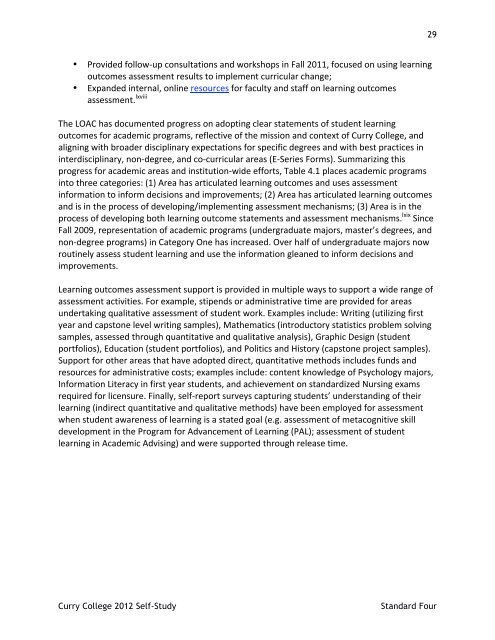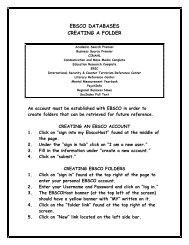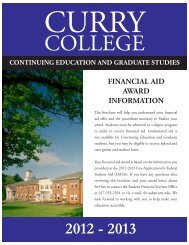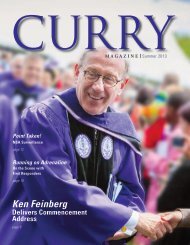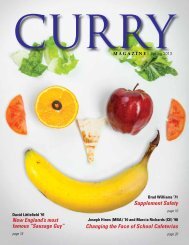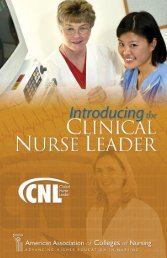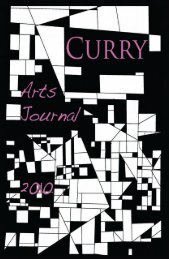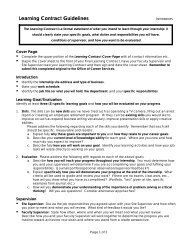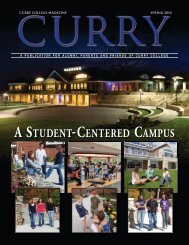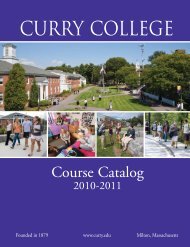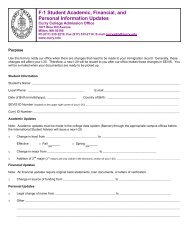Read the Curry College NEASC 2012 Self-Study Report.
Read the Curry College NEASC 2012 Self-Study Report.
Read the Curry College NEASC 2012 Self-Study Report.
Create successful ePaper yourself
Turn your PDF publications into a flip-book with our unique Google optimized e-Paper software.
29<br />
• Provided follow‐up consultations and workshops in Fall 2011, focused on using learning<br />
outcomes assessment results to implement curricular change;<br />
• Expanded internal, online resources for faculty and staff on learning outcomes<br />
assessment. lxviii<br />
The LOAC has documented progress on adopting clear statements of student learning<br />
outcomes for academic programs, reflective of <strong>the</strong> mission and context of <strong>Curry</strong> <strong>College</strong>, and<br />
aligning with broader disciplinary expectations for specific degrees and with best practices in<br />
interdisciplinary, non‐degree, and co‐curricular areas (E‐Series Forms). Summarizing this<br />
progress for academic areas and institution‐wide efforts, Table 4.1 places academic programs<br />
into three categories: (1) Area has articulated learning outcomes and uses assessment<br />
information to inform decisions and improvements; (2) Area has articulated learning outcomes<br />
and is in <strong>the</strong> process of developing/implementing assessment mechanisms; (3) Area is in <strong>the</strong><br />
process of developing both learning outcome statements and assessment mechanisms. lxix Since<br />
Fall 2009, representation of academic programs (undergraduate majors, master’s degrees, and<br />
non‐degree programs) in Category One has increased. Over half of undergraduate majors now<br />
routinely assess student learning and use <strong>the</strong> information gleaned to inform decisions and<br />
improvements.<br />
Learning outcomes assessment support is provided in multiple ways to support a wide range of<br />
assessment activities. For example, stipends or administrative time are provided for areas<br />
undertaking qualitative assessment of student work. Examples include: Writing (utilizing first<br />
year and capstone level writing samples), Ma<strong>the</strong>matics (introductory statistics problem solving<br />
samples, assessed through quantitative and qualitative analysis), Graphic Design (student<br />
portfolios), Education (student portfolios), and Politics and History (capstone project samples).<br />
Support for o<strong>the</strong>r areas that have adopted direct, quantitative methods includes funds and<br />
resources for administrative costs; examples include: content knowledge of Psychology majors,<br />
Information Literacy in first year students, and achievement on standardized Nursing exams<br />
required for licensure. Finally, self‐report surveys capturing students’ understanding of <strong>the</strong>ir<br />
learning (indirect quantitative and qualitative methods) have been employed for assessment<br />
when student awareness of learning is a stated goal (e.g. assessment of metacognitive skill<br />
development in <strong>the</strong> Program for Advancement of Learning (PAL); assessment of student<br />
learning in Academic Advising) and were supported through release time.<br />
<strong>Curry</strong> <strong>College</strong> <strong>2012</strong> <strong>Self</strong>-<strong>Study</strong><br />
Standard Four


